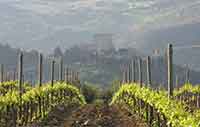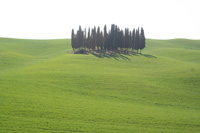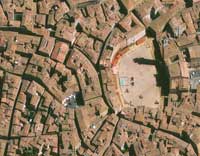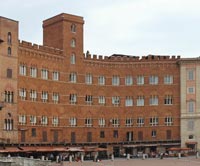 |
|
Andrea Bonaiuti, Way of Salvation, 1365-68, fresco, Cappella Spagnuolo, Santa Maria Novella, Florence |
|
Andrea Bonaiuti da Firenze |
| Andrea da Firenze, also known as Andrea Bonaiuti, was a Florentine fresco painter whose considerable ability is demonstrated by his works in the church of Santa Maria Novella in Florence. Also attributed to him are the decorations in the Spanish chapel and the cartoon (full-scale drawing) for the stained-glass window of the facade. Although he was acquainted with Giotto’s innovations in modelling and spatial depth, he was strongly influenced by the linear, hieratic art of his Florentine contemporary Andrea Orcagna, and most of his works display the rigid compositions and immobile faces associated with the Byzantine tradition. From January 1346 he was registered in the Arte dei Medici e Speziali in Florence. The earliest paintings that can be attributed to him suggest that he must have formed a close association with the workshop of Andrea di Cione. The small portable triptych of the Virgin and Child with Saints and Angels (centre panel, Copenhagen, Statens Museum for Kunst; side panels of the Nativity and the Crucifixion, Houston,Museum of Fine Arts) shows the influence of Maso di Banco and of the painter of the Strozzi Chapel frescoes in the Chiostrino dei Morti, Santa Maria Novella, Florence. At the end of 1365 Andrea Bonaiuti was commissioned to decorate the chapter house of the church of Santa Maria Novella. This is a church of the Dominican Order, and the frescoes, illustrating the Triumph of the Faith and the Dominican doctrine, in both their severity and their meticulous detail, accorded with the expository style of the Dominican preaching friars. Andrea is last recorded in 1377 working on frescoes of the Life of St Raynerius in the Campo Santo at Pisa. |
Andrea da Firenze or Andrea Bonaiuti was a Florentine painter. From January 1346 Andrea Da Firenze was registered in the Arte dei Medici e Speziali in Florence. The earliest paintings that can be attributed to him suggest that Andrea Da Firenze must have formed a close association with the workshop of Andrea di Cione. The small portable triptych of the Virgin and Child with Saints and Angels (centre panel, Copenhagen, Statens Museum for Kunst; side panels of the Nativity and the Crucifixion, Houston,Museum of Fine Art) shows the influence of Maso di Banco and of the painter of the Strozzi Chapel frescoes in the Chiostrino dei Morti, S Maria Novella, Florence. Andrea da Firenze is remembered mainly for his frescoes in the Spanish Chapel of Sta Maria Novella, Florence. This is a church of the Dominican Order, and the frescoes, illustrating the Triumph of the Faith and the Dominican doctrine, in both their severity and their |
|
||
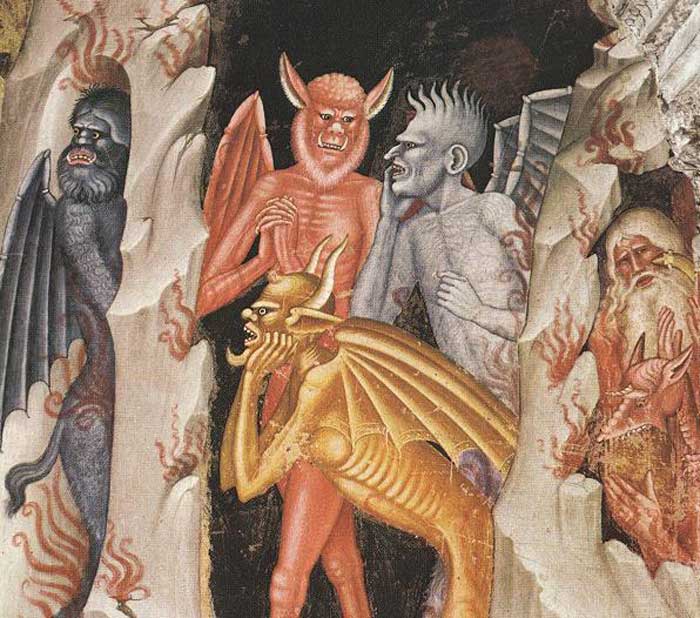 |
||
Andrea Bonaiuti, Descent of Christ to Limbo (detail), 1365-68, fresco, Cappella Spagnuolo, Santa Maria Novella, Firenze
|
||
|
||
Selected bibliography
|
||||
|
||||
Podere Santa Pia, northern terrace view |
Podere Santa Pia |
Podere Santa Pia, giardino |
||
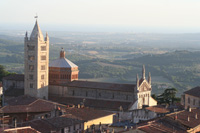 |
||||
Val d'Orcia" tra Montalcino Pienza e San Quirico d’Orcia. |
Siena, Piazza del Campo |
Massa Marittima |
||
 |
||||
| Panorama Sant’Angelo in Colle, Montalcino | Siena, Palazzo Sansedoni |
Firenze, Duomo |
||
The Dominicans The Dominican monks, Sisto and Ristoro, are traditionally credited with the planning and construction of the Church of Santa Maria Novella in Florence. The plan of the building, a Latin cross with square chapels jutting out from the east side of the transept, was used for Franciscan models. The dynamic concept differs, from the slender cross vaults to acute pointed arches separating the nave, but with a greater spatial unity. In the second half of the 14th century, Andrea di Bonaiuto painted the wonderful frescos for the adjacent Spanish Chapel, in which the picture of the Church of the Triumph of the Faith closely resembled Arnolfo di Cambio's design for the cathedral, Santa Maria del Fiore. The spatial integrity of the building is already implicit in Arnolfo's plan of 1294. but the dome of the fresco model is augmented by Brunelleschi's octagonal drum that carries the dome. Another example of Dominican theology is Bonaiuto's fresco cycle showing Thomas Aquinas dominating the allegorical figures of all the liberal arts and the sciences of the theological cursus.
|
||||
| This article incorporates material from the Wikipedia articles Andrea di Bonaiuto and Basilica of Santa Maria Novella published under the GNU Free Documentation License. | ||||

